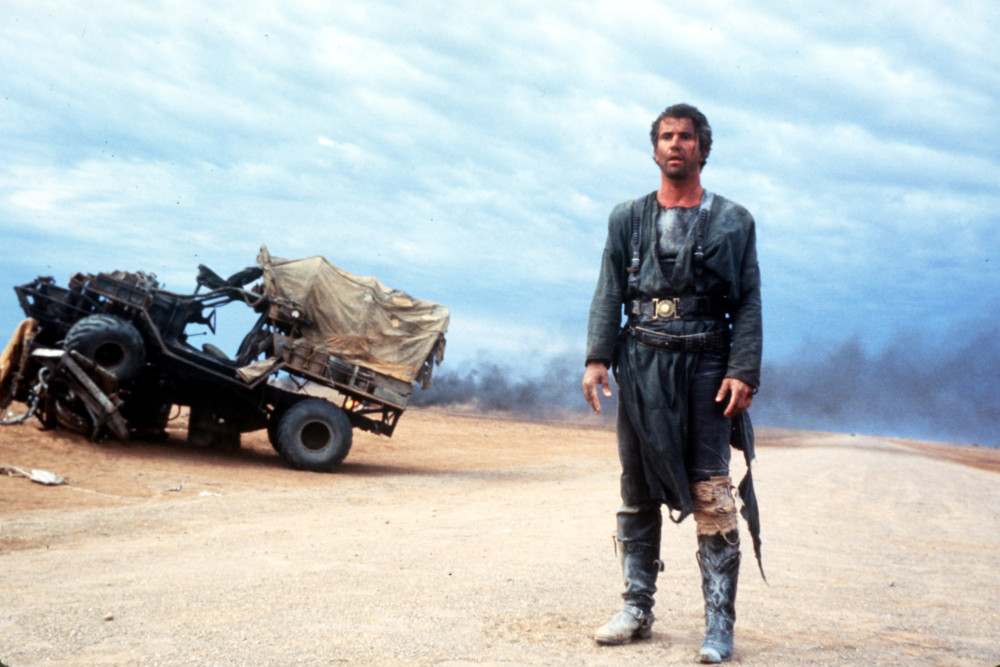The end of the world is not what it used to be. Fury Road is not Mad Max.
Fury Road is a fast, loud, spectacular, fight-scene, car-chase, big-explosion action film; but, though it seems strange to say, the original Mad Max was, in its way, a slow and even a quiet movie. While Fury Road is relentless in applying its high-volume, high-velocity, high-violence formula, with barely a pause between frenzied battles, Mad Max lingered in long, still moments, alternately banal and desolate. For a film that was in large part about fast driving and senseless mayhem, Mad Max really took its time, and it was the strained sense of anticipation, rather than stunning moments of explosive action, that supplied its sickening, despondent effect.
The climactic final scene, in which Max chains his enemy to a truck and rigs it to explode, then leaves him a hacksaw and the advice that “it will take you ten minutes to hack through” the handcuffs, but “you can hack through your ankle in five” — turns exactly on this sense of time, and the fear of what is coming rather than the image of what is happening. Here, as with the death of Max’s family, the most horrific violence does not even appear on the screen. What we imagine is worse than what we actually see.
Recall, too, the most stressful moment in the series: the long, agonizing scene in which Max, mostly crippled, lies in the road, arm outstretched, reaching, reaching for his gun, while in the background a motorcycle approaches, bearing down on him, full throttle. I have seen that minute of film a dozen times, probably, and I always find myself hoping, rather desperately, that this time, he will reach the gun, or roll away at the last second, or just pull back his arm. Of course he doesn’t. And, if we were really paying attention, we would know even at the first viewing that he won’t.
Fury Road is more optimistic. It tells the story of a group of women escaping sexual slavery, aided by Max — who is escaping slavery himself — then returning to the water-rich fortress where they were held, killing the warlord, and triggering an uprising. The film ends at the moment of their victory, and the promise at the end — or the hope, rather — is that civilization might be rebuilt on a more humane and egalitarian basis, that human beings might be redeemed.
It’s a long way from the apocalyptic finish of the first film — Max driving into the wasteland, becoming at last one of the barbarians he has spent the movie fighting. Mad Max shows us a slow apocalypse. The end comes not as a matter of nuclear war or biblical cataclysm, with a creeping nihilism tha overtakes everything, including eventually the hero himself. The film shows us what it is like as civilization fails — not merely its institutions, but its values and norms. The stumbling pace and grainy visuals, the marked lack of polish in every regard, all contribute to its hopeless mood, its disconcerting atmosphere, and its lasting, haunting quality.
It is for these same reasons, I think, that Mad Max still speaks to us. Human extinction has only been a real possibility for about half a century. For most of that time, the acknowledged threat was nuclear war. Now it is the destruction of the natural environment. Our apocalypse is slower, and it is therefore harder to conceptualize even as we begin to feel its effects. It is harder to face, and harder to fight. Armageddon, it turns out, will not come as a final battle with mushroom clouds on the horizon and cities reduced to dust, but as a slow rise in global temperatures, the acidification of the oceans, and wildfires, draught, refugee crises — in other words, the nightly news. It is not a question of a few men doing something to end the world, but of all of us doing nothing to save it.
“Who killed the world?” one of the escaping concubines demands. The answer is that we did. Or more to the point: We are — right now, every day.
The future Fury Road presents is a judgement on the present — but also a warning and a challenge. It makes our choices very clear. As the slave-brides learn, at first to their sorrow, escape is impossible for the simple, terrifying reason that there is nowhere to escape to. The promised green utopia is a poisoned wasteland plagued with crows. The only hope for freedom, then, is not escape but rebellion.
The feminism of the message has been much remarked on. But the system the warrior women overthrow is not only patriarchal. It is a political economy in which those who control the resources needed for life, water especially, use that control to enslave some people and reduce others to sordid destitution. It is a military death cult dependent on adolescent skinhead “War Boys” eagerly sacrificing their lives for the glory of battle. And it is a personal dictatorship, with the ruler feared and obeyed almost like a god.
The women — is it too much to call them Furies? — succeed in killing the tyrant. Yet it is far from certain what will come next — and it is uncertain, most of all, for Max. Every film in the series has ended with Max outside of civilization. At the end of the first film, he renounces the old world, its laws and morals, and drives into the desert alone. In Fury Road, it seems, he renounces the new world as well. As the women — once captives, now liberators — ascend into the Citadel of power, Max again turns away. He disappears into the crowd without a word.



















